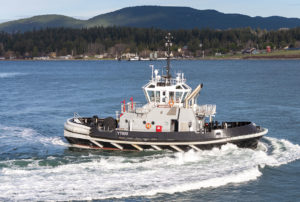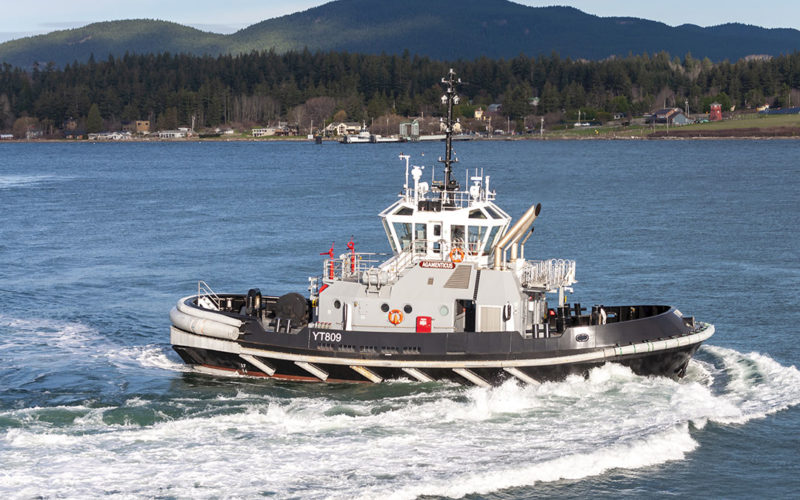
The U.S. Navy has launched a new class of tugboats that will replace aging YTBs on both coasts.
YT 808 (Rainier) left Dakota Creek Industries last fall for Naval Base Kitsap in Washington state, where it has worked since October 2020. YT 809 (Agamenticus) left Puget Sound in March atop a barge bound for Portsmouth Naval Shipyard in Kittery, Maine.
The 90-by-38-foot tugboats are updated versions of the YT 802 class of tractor tugs built a decade ago. The new series features an updated Robert Allan Ltd. Z-Tech 4500 design and twin 1,810-hp Caterpillar 3512E Tier 4 engines. They are the first tugs in the Navy fleet with engines meeting EPA Tier 4 emissions standards.
Like its predecessor, the YT 808 class is built for all-purpose towing and ship-assist work ranging from aircraft carriers to destroyers to deck barges. The new class has modern navigation electronics and upgraded towing equipment as well as the new engines.
“This is the Navy getting the right tool for the right job,” said Capt. Tim Hartman, who spent three decades in the Navy and is now a civilian port captain at Navy Region Northwest. “And at the same time, it is environmentally friendly and doing the right thing for the future.”
The Navy has relied on its fleet of 2,000-hp YTBs for ship-assist work for generations. American shipyards built 77 of these single-screw tugs in the 1960s and 1970s. Many later entered commercial service or were transferred to allied nations around the world.
Three original YTBs still operate in Navy Region Northwest, a sector that includes the Puget Sound Naval Shipyard, Naval Submarine Base Bangor and Naval Station Everett. Two other Navy tugs in Puget Sound are converted YTBs with two Cat 3516s linked to z-drive thrusters.
The rest of the eight-tug Northwest fleet is composed of YT 808 and two YT 802-class tugboats. Five of the six YT 808-class tugs on order will stay in the Pacific Northwest, replacing all but one converted YTB. YT 809 will replace a YTB operating at Portsmouth Naval Shipyard.
“The primary reason (for the new class) is to replace the old YTB tugboats,” said Dan Shimooka from the Navy’s Program Executive Office Ships, which manages design and construction of assets ranging from destroyers to support vessels. “We are buying new, modern tugboats that are increasing our capabilities by a huge margin.”
The Navy began thinking about replacing its YTB fleet in the late 1990s. In the mid-2000s, the service developed performance requirements for the replacements. The Navy wanted tugboats with enough power and versatility for a wide range of towing operations, Shimooka said.
Rather than reinvent the wheel, the Navy looked to existing commercial tugboat designs to meet those needs. Naval architects at Robert Allan Ltd. in Vancouver, British Columbia, modified their proven Z-Tech 6000 platform into a smaller Z-Tech 4500 package optimized for harbor towing. J.M. Martinac in Tacoma, Wash., built six 90-foot Valiant-class YT 802 tugboats between 2009 and 2011.
Dakota Creek of Anacortes, Wash., won the YT 808 project in bidding against 15 other shipyards, Shimooka said. The Navy rated each bid and awarded the contract based on a “best value” model that weighs the design and other factors rather than just the low bid. The total cost for the six tugs is $84 million.
YT 808 shares the same Z-Tech 4500 hull as the YT 802 tugs, albeit with some notable changes. The engine room was redesigned to accommodate selective catalytic reduction (SCR) modules paired with the Tier 4 Cat engines. The SCR units are installed forward and above each main engine.
“(The SCR) units are big and bulky,” Evan Gatehouse, project director and senior naval architect at Robert Allan Ltd., told Professional Mariner last fall. “They are continuing to be a challenge because tugboats already have a crammed engine room. These units are almost half the volume of an engine, so finding room for them you basically need to reconfigure. … Previously, it was a straightforward exhaust system.”
Other changes in the engine room include the placement of day tanks in the main engine space; the addition of 1,000-gallon diesel exhaust fluid tanks on the port and starboard sides of the z-drive compartment; and the installation of the generators along the centerline, one in front of the other, between the mains.
With the changes taken together, the new vessel has a different feel than its forebears. “The operators said it, and I noticed it too. It feels solid,” Hartman said. “You only really know it when you sit in the helm seat. It feels solid and sits lower in the water.”
The propulsion package for the new class remains virtually unchanged from the YT 802 tugs, aside from the Tier 4 classification. The Cat 3512s turn Schottel z-drives through Twin Disc reduction gears. The starboard engine has a power takeoff driving a Counterfire fire pump that supplies 2,000 gallons per minute to two forward-facing Stang fire monitors. Electrical power comes from two 154-kW John Deere gensets.
“We wanted to stick with not only what works, but the end users already know how to operate and maintain the equipment on the previous class,” Shimooka said. “We try to keep the equipment the same unless there is a new requirement, or unless the previous equipment didn’t work.”
In an era where 90 tons of bollard pull is becoming the norm, the YT 808 tugs get the job done with less than 50 tons. Over consecutive days last winter, the new tugs assisted the decommissioned USS Kitty Hawk aircraft carrier into dry dock, moved a destroyer and shifted a deck barge.
“Everybody wants 7,000 horsepower, but 7,000 horsepower isn’t always what you need,” Hartman said. “We are under 4,000 horsepower and we just pulled a 1,000-foot LMSR (for Military Sealift Command) at easy bell. It is so multi-missioned.”
The YT 808s have finesse not possible on the YTBs thanks in part to slip clutches on both Twin Disc gearsets. These systems give the operator more control when coming alongside a ship or submarine hull, Hartman said. They also produce less wheel wash in sensitive environments.
The deck equipment has been upgraded on the YT 808 class as well. The single aft bitt on the YT 802 tugboats was replaced by a sturdier H-bitt for towing off the stern. The aft deck also has a JonRie InterTech Series 421 capstan to help with line handling.
A JonRie Series 210 hawser winch on the bow has a line pull of 20,000 pounds and brake holding force of 300,000 pounds. The single drum is spooled with 2.25-inch Cortland Plasma line. The working deck is covered with nonskid coatings for safer operations in damp weather.
Aft of the house, the Navy installed an improved hydraulic articulating brow that has a greater weight capacity and is easier to operate than the one installed on the previous series. The brow extends from the tugboat to the deck of a submarine for pilot and personnel transfers. Undertun, based in Norway, initially developed the system for crew transfers between vessels and offshore wind turbines.
The fendering arrangement on YT 808 was changed to better accomplish its mission. The heavily protected bow has two rows of cylindrical fenders and a lower course of “W” fenders. The sides above the waterline have diagonal rubber sections for handling barges with low freeboard. Schuyler Companies supplied the fendering system, which includes non-marking gray above the waterline.
Below the surface, the skeg’s leading edge used for nudging submarines is swathed in protective rubber. The tug has a metal guard aft on the port and starboard sides to prevent contact between the z-drives and a submarine hull when alongside. These guards, and much of the tugs’ sides, also are protected by fenders.
YT 808 operates with a four-person crew. In the Pacific Northwest, those mariners are civilian Navy employees who are assigned to a single tugboat. They typically work eight-hour stints and go home when the job is done for the day. The tugs operate as day boats, although they do have overnight accommodations for six people.
The main deck forward of the fiddley has a small galley and comfortable crew lounge area, along with cabins for the captain and chief engineer, and a head with a shower. There are two double rooms with a bathroom forward of the engine space.
The wheelhouse is enclosed by floor-to-ceiling windows affording excellent visibility in all directions. The operator sits forward between two control stations and Furuno navigation electronics. The vessel also has a closed-circuit TV system.
“It has much newer technology,” Hartman said, comparing the YT 808 class to the YTBs. “From the navigation electronics to the winch with the foot controls, it is just moving us from the 1970s technology to current technology.”
At press time, YT 808 was the lone tug in the series in service. But it won’t be that way for long. YT 809 (Agamenticus) was scheduled to arrive in Kittery, Maine, in late May, where it will go to work assisting submarines at Portsmouth Naval Shipyard. Delivery of the third tug in the series, YT 810 (Deception), also was scheduled for late May.

